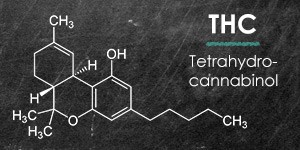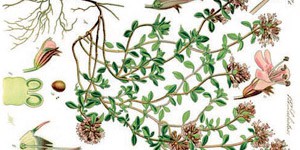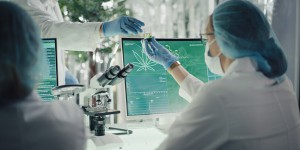By Geary Coogler

A graduate of Texas A&M University's School of Agriculture with a Bachelor of Science degree in Horticulture/Floriculture, Geary has more than 30 years of experience in the greenhouse industry, with the last 14 years in the Indoor Gardening industry. His experience ranges from business development to research. He currently serves as agricultural engineer fulfilling a variety of roles from advisory and regulatory to technical and writing. Geary is a member of both the International and American Society of Horticulturist and the American Horticultural Association. When not working, Geary serves his community as a volunteer firefighter, enjoys the outdoors, and dabbles with home improvement. A native of the southern reaches of the USA, Geary now makes his home in the Green Mountains of Vermont.
A strong foundation for anything in life is required for success, whether it is a building, an idea, or even a person's character. This is no less true than in a plant. Half of a plant's mass is located in the medium, and the plant mimics the composition of the medium. Vintners are usually known for their abilities to discern a region from which a wine grape comes due to the qualities imparted by the native soils of those regions. These are the foundations of the crop and one that holds true across most plant species.
Each medium contains different ratios of nutrients, microbes, and non-nutritive components that some plants are well adapted at pulling from the medium. These elements may not become incorporated in the plant structure or produced compounds, but they remain to the end and affect, negatively or positively, the end consumer of these products.
The idea of the foundation affecting the plant in this way is not confined to native soils but equally as affecting, if not more so, in the use of highly controlled or designed mediums such as peat mixes, sands, even where the foundation is the air itself. Plants are as direct a reflection of the medium in which they are grown, its composition, content, and structure, as it is the materials which might be applied. Plants are, in a way, surface based filters for the soil, and some plants are really good at it.
Good Quality Medium
Whether the medium of choice is air, soil, water, or the myriad of components that are used to base a plant in, its characteristics must meet the needs of the plant. Good design starts here. All plants evolved in a particular system of these, and using the tools of porosity, chemistry, and consistency, a medium can be designed to fit the needs of a plant. It could be low concentrations of nutrients in a warm highly aerated bath of water to adding organic materials to increase nutrient storage sites and water holding capacity. Whatever a plant needs can usually be duplicated, however, there is no substitute for cleanliness.
A medium must be free of disease and pests. It must be also be free of any other contaminant that, while not always affecting the plant negatively (some even positively), will hurt the consumer or handler of the harvested product. These issues are never easy to fix or clean up, even where the problem was introduced in the making of the parent material or additions to be used as grow medium. This includes simple less apparent things such as pH control (lime), pre-fertility charges, even the water used to in production or packaging.
The Problem: accumulation of toxins
Everything the plant sees, grows in, breathes, or drinks is suspect for contamination, something that if it exists in the plants environment, can cause harm. This is the gist of the problem: The plant accumulates anything that comes in that it cannot use. There are no waste disposal services for the plant's cells. It comes in and is either used or shuttled off to the cell's own On-Site trash Dump, the vacuole. This is basically a bag of water in which some things can be stored, or forgotten.
Ions (basically charged individual elements like Calcium or complexed groups like Nitrate), like heavy metals, float through the plant tissue, through each cell, on the cellular currents and, if not picked up for use in a compound or cellular function, are swept up into these bags as excess. Here they can remain as an element like Lead or they can meet up with other ions and form bad compounds such as Nitrosamines. In any case, unused heavy metals, compounds, and even unused fertilizer elements can be stored here, and added to, across time. Now the cell has become an accumulator and concentrator of these unused items since they never come out of the cell, being just bagged and stored in the cell. Lead, for instance, may come in as impurities in the lime or in many mineral fertilizers, even in organic fertilizers sourced from high lead containing organic materials, and may come in at a relatively small dose of say 1 part per million (ppm) daily, but over the course of a growing season of 180 days suddenly adds up to 180 ppm lead, which is an issue. Since the human body will also store this lead, every 180 ppm dosage adds to what is present until a big problem occurs. Cumulative effects are real and can be deadly.
These potential contaminants can occur in anything added to the growing effort. It goes without saying that fertilizers applied are the biggest source, either from contamination or very poor design, but just as critical is the base material of the medium Peat can be contaminated in peat mixes, coco, rockwool, mineral soils, water, and the air can all carry contamination. Even organic materials derived from organic material can be a source. A crop of hemp grown organically on an old industrial site and turned into compost will take with it high levels of many heavy metals and radioactive materials, which will be transferred to the new plants as the old decompose and release these now high levels of contamination.
The key to avoiding this is in the quality of the input materials. Use high quality medium, know what the water has in it removing contaminants if necessary, and clean nutrients as inputs to keep the problem limited. Make sure the pH is always under control and correct to control and ensure proper nutrient availability. Have the inputs tested for the heavy metal ions so you know what the plant is exposed to. Most importantly, get the cultural conditions and growing techniques correct to limit root health issues, denial of oxygen, temperature stressing, and all the other issues that will affect plant health and ion uptake by the root system.
The Discussion
Many plants, for untold reasons, have the ability, and sometimes affinity, for taking up elements which are non-nutritive. It has been known for decades that some materials can cross into the plant tissue with little change. Even some complex organic molecules have this ability, or can be aided by other compounds to make the crossover. This is especially true with heavy metal elements, which will be taken up alongside the normal nutritive heavy metals such as Iron or Manganese. Over micro-nutrient fertilization is a primary cause of heavy metal toxicity even without the non-nutritive ones. Once inside the tissues and in the transport vessels of the plant, these move all over the plant to all the cells. They diffuse through the cell walls and, at some point, are swept into the vacuoles. Here they concentrate and remain after harvest, whether in a fresh green state or dried for use, where the toxicity is further concentrated by the drying process.
This ability varies to one degree or another across plant species, but some plants can be fairly aggressive in their take-up of these problem elements, the Hemp plant being one of the best. It is currently used in many parts of the world to do a variety of tasks in what has become the science of Bioremediation.
Mass plantings are being done along estuaries and river junctions to remove toxins from the water before they reach the sea. It is being used at old industrial sites and Hemp is especially good at taking up Uranium and Lead. When the crop is finished, the plant mass is removed and taken to be treated for these high level hazardous wastes, and another crop planted right behind it. In short, these plants will find these issues in the medium and capture it, but will not let it go until the plant is destroyed, which includes consuming or decomposing.
The Conclusion
It is critical that the grower understand the information just laid down here. Especially where a crop will be handled or consumed by others. Even where a crop does not have immediate toxic results but is high in the acceptable range, people and animals that cannot filter these problems, or have compromised health issues, will react much worse than the average person. The grower must remember that even very small amounts will be amplified in the final harvest many times over. The grower must closely monitor all sources of the medium, water, fertilizer, and air to which the plant is exposed and add up all the numbers to understand the possible results.
As a grower, it is their responsibility to use only the best sourced materials, not the cheapest. They must control the amounts of fertilizer applied not correct and necessary levels; a responsible choice. Selection of nutrients should be based not only on consistency and quality, but also on these heavy metal loads, which should be available from any producer on request. Whatever the grower does, they must never discount the effect of the medium on releasing, storing, and contributing to the heavy metal load and the presence of other toxins. Even the water itself must be known. Look at the mediums activity across time as well. As material decomposes, it returns to its base state. Make sure the medium is tuned to the correct pH as too high or too low will cause a release of many of these locked up compounds and elements releasing a flood of problem on the plant, even for a single day. As the saying goes, Knowing is Growing, and Measuring is Knowing. Know what is in the medium and environment before it finds its way into the plant and into a consumer.
The American herbal pharmacoeapea guidelines for daily intake of chemical residues:
| Contaminant | Limit of daily intake in micrograms |
|---|---|
| Arsenic | 10 |
| Cadmium | 4,1 |
| Lead | 6 |
| Mercury | 2,0 |


